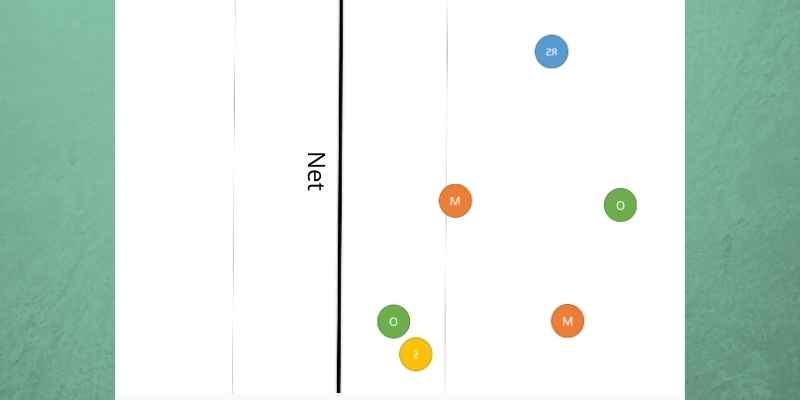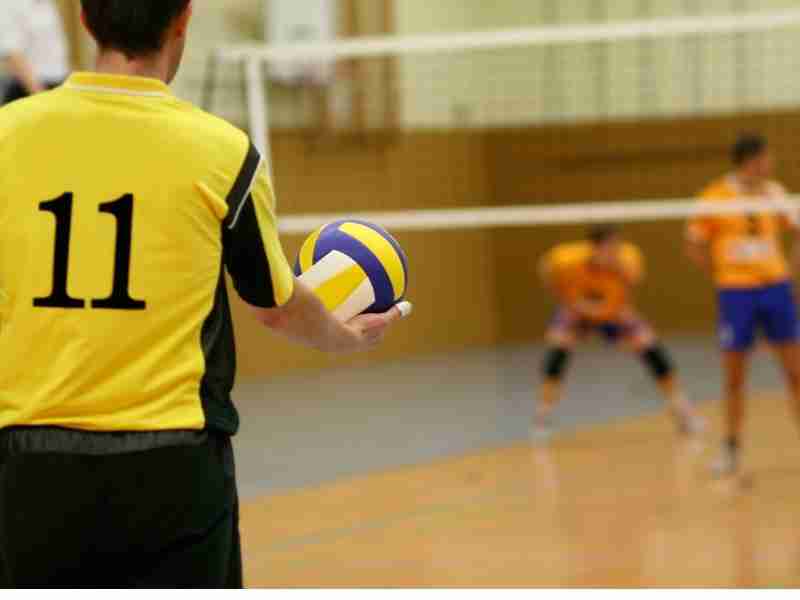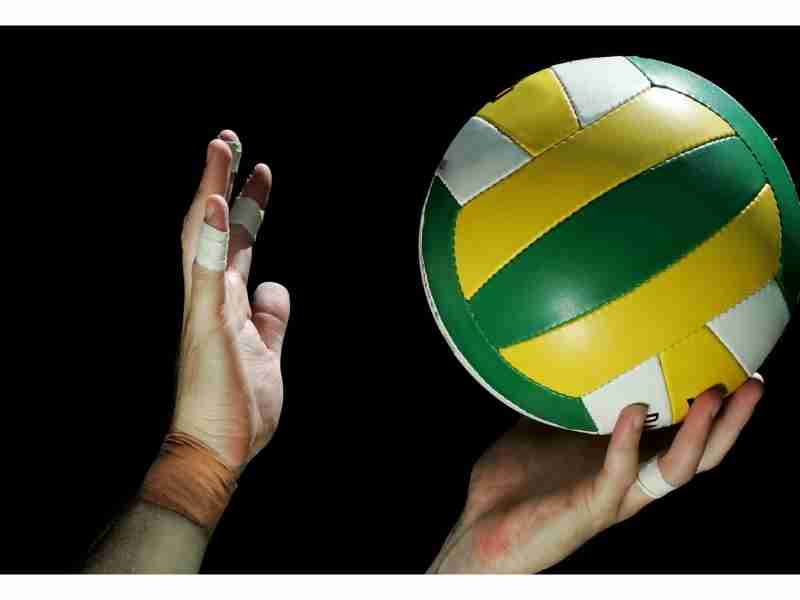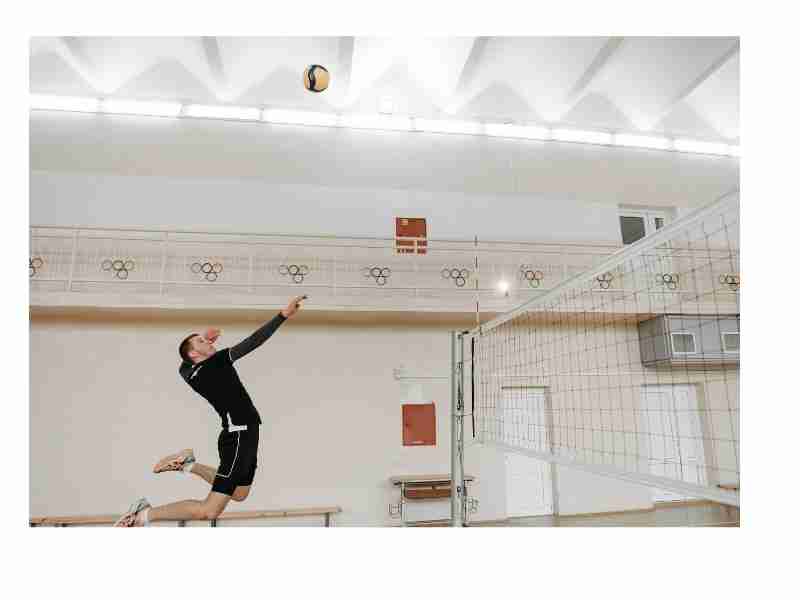
As a volleyball player, you know that the 6-2 rotation is one of the most common schemes in volleyball. But do you know how to take advantage of it? This blog post will explain how to use the 6-2 rotation to your advantage and score some points.
Basics of the 6-2 Volleyball Rotation
You should know some basics about the 6-2 volleyball rotation. Namely, the back row players are responsible for hitting the ball over the net, and they should try to stay in a straight line from the net to avoid being blocked. Additionally, it’s essential to know where each player is supposed to be on the court at all times, as this can help prevent confusion and make it easier to set up plays.
After The First Pass, The Back-Row Setter Should Be Right Of the Centre
A good rotation is essential for volleyball success. All players are strategically positioned to defend and attack the opposing team. A rotation can be set up in various ways, but one of the most important things to remember is that the pass should always be intended for the same location.
While the setter may not be able to get into the perfect position every time, whether due to a bad pass or another variable, having a consistent starting point allows for consistency and predictability, this allows the rest of the team to adjust their own positioning accordingly, making a successful play much easier to execute. It also keeps your opponents guessing by not changing your patterns too frequently.
Overall, having a good rotation is essential to playing volleyball well. Keeping the pass in the same spot ensures that your team is always in a position to succeed.
Player Positions Must Be Predetermined
Players must be in their respective positions before the ball crosses the net to generate an ideal volleyball rotation. The play will not go as smoothly if players are not in position.
Setters should move to their position to the right of the center to make setting the ball easier while hitters prepare for the approach swing. Thus, everyone on the court is in the proper position at the appropriate time, and the ball can be set up for a kill.
If players do not follow this rotation, it won’t be easy to run plays, and the team will not be as successful. Therefore, it is vital that players are always aware of their position and where they need to be on the court.
Observe The Active Setter
The setter is one of the most critical players on the volleyball court. They are in charge of the offense and making strategic decisions that can help their team win. As the primary source of information for the team, they must stay in control of the game even when they are not in the setter position. By giving explicit instruction, the setter can help their team get more out of each game.
Protecting The Back-Row Setter
In a 6-2 rotation, the back row setter is often left vulnerable to opposing hitters. While the 5-1 may be the most popular volleyball rotation, the 6-2 has certain advantages that make it a compelling option for teams.
With the back row setter hidden, it’s easier to disguise the team’s intentions and run complex offenses. The setter is also always in the perfect position to run the play, making it a more efficient option.
In addition, more time can be spent on hitting as opposed to receiving and setting, and more options are available with the extra hitter. Overall, the 6-2 rotation has many benefits, making it a top choice for volleyball teams.
Formation of the 6-2 Rotation
The 6-2 Volleyball Rotation is a formation used in competitive play. It employs two setters, one in the back row and one in the front row, with all other players rotating clockwise around them. This rotation allows for maximum coverage of the court and efficient ball movement.
There are several benefits to using this particular rotation. Firstly, it ensures that a setter is always available in the back row, which is essential for quick ball movement.
Secondly, it allows for more excellent court coverage, as all players are positioned around the perimeter. This is especially beneficial in serve-receive situations, as it prevents crossing and allows for better communication between teammates.
Overall, the 6-2 Volleyball Rotation is a formation that provides many benefits and should be considered for use in competitive play. It allows for quick ball movement, efficient coverage of the court, and better communication between teammates. If you want to improve your team’s performance, this may be your rotation.
What Is a 6-2 Offense?
Most volleyball teams run some variation of a 6-2 offense. This offensive formation gives you a few hitters attacking the other team’s court while leaving three players back to defend your court. It is an easy formation to learn and adjust to, making it a popular choice for many teams.
A 6-2 offense will typically spend more time in serve receive than other formations. This is because there are only two front-row attackers. This leaves three back-row defenders to cover the entire court. As a result, teams running a 6-2 often have powerful serve receive.
The constant rotation of hitters in a 6-2 can confuse the other team. Every time the ball is served, one of the front-row attackers will rotate to the back row. This means there are always fresh hitters attacking the other team’s defense.
This continuous rotation also makes it difficult for the other team to focus on any one player or area of the court. By keeping the ball moving around, teams running a 6-2 offense can find openings in the defense and score some easy points.
Importance 6-2 Rotation
The majority of volleyball teams utilize a 6-2 rotation. This rotation makes it easier to balance playing time and is ideal for younger teams or teams with an emphasis on playing time parity. The 6-2 rotation allows more frequent substitutions, allowing more players to take the court. This rotation is also an excellent way to maintain player interest and participation in the game.
There are only three rotations that players need to know to understand the game. These rotations are numbered 1, 2, and 3, and they are easy to remember once you know Rotations 4, 5, and 6.
If one player forgets where they are supposed to be, another player can help them out. This makes things easier for the coach and lessens their responsibilities. Players of all ages can learn volleyball more easily with this method.
Most people are familiar with the standard volleyball rotation of 6 hitters. However, using a 3 hitter system in the front row, you can keep your opponents guessing and make it more difficult for them to defend against your attack.
This system also allows you to continue to set even if you lose one of your hitters, and the setter comes from the back row, making it more difficult for opponents to prepare. Height is less relevant on defense with this offensive system, and the ability to contribute to defense is key for this position. This system makes it difficult for opponents to prepare and defend against your attack and can give you a significant advantage in a match.
A three-hitter rotation volleyball serve receive strategy is an excellent way to keep your opponents from getting into a good rhythm. By using this strategy, you also don’t have to eliminate a hitter to set. This can be a significant advantage, especially against a team with an outstanding middle blocker. The setter usually comes from the back row in this system, making it hard for opponents to prepare.
Another plus is that height isn’t as crucial on defense in this system. All that matters is that you have good defensive skills. This can be a big help if you play against a team with very tall players. The 6-2 rotation can make it difficult for opponents to game plan against you. It can give you a significant advantage if you use it correctly.
More Hitters Up Front
The 6-2 rotation benefits teams with more hitting options by allowing for more substitutions. This assumes the setter is subbed out when the front row rotation begins.
Even when substitution limits apply (as in international rules), the 6-2 provides excellent flexibility. One of the main advantages of the 6-2 volleyball rotation is having three natural hitters on the front row at all times.
This rotation allows your team to be more aggressive with their hitting, as there are always three hitters in the front row. This can give your team an advantage over the other team, who may only have two hitters in the front row at specific points during the game.
The 6-2 volleyball rotation is a great way to keep your team fresh and give everyone a chance to play. It also allows you to put your best hitters on the court at all times, which can help you win more points and ultimately the game.
A Second Setter on the Floor
The 6 2 volleyball rotation is a great way to keep your team organized and running smoothly. Having two setters on the court at all times provides flexibility and allows for more creativity in terms of play-calling. If you’re looking for a way to give your team an edge, the 6 2 volleyball rotation is a great option.
You will have two setters on the court at all times. This will let the other players be more flexible with their serve receive. This way, they do not have to worry as much if the setter takes the first pass and is ruled out of the set.
Even if the player in the back row is eliminated, you’ll still have someone in the front row. The player in the front row can set in this case, allowing your team to run some play with a setter as the first passer.
This flexibility is helpful because teams don’t have to rely on one setter. They can instead have two setters who can help run the offense. This also allows for more creativity in setting plays, as the setters can be used differently to keep the opposing team off-balance.
Rotation 1
By the assumption that most teams will deploy a libero and an outside hitter to facilitate ball passing, our patterns will be constructed accordingly. For a few sets, we’ll be able to use the right-side hitter as a passing option, so we’ll show you how to do that so you can switch up your serve receive strategy.
We will move OH1 back to pass with the Libero and OH2. This will lead to more out-of-position serving and batting from our team (the right-hand player hits on the Left and the left-hand player hits from the Right).
Rotation 1 And 4 Alternative Formations
In the first rotation, there are two common alternatives. Stacking is depicted on the left side of the previous image. When an outside hitter from the starting lineup shifts to the left side of the court, it allows the team to pass.That way, the middle and the outside hitters can continue using their typical batting stances.
If the RSH has to hit something out of his comfort zone, he may need to hit a combination with the middle man, a sliding shot, or a three-two. Or, if he needs to run across the court to reach the ball before it hits the ground, he might be able to hit a right-sided shot.
If you want to play the second alternative, you’d move the OH1 player up and put him behind the baseline, and then you’d move the RH2 player down and into the middle. After the ball has been crossed, they can switch places, as both players will be hitting out of position during their initial attacks.
Rotation 2
In rotation two, the front row OH drops back and passes while the setters push up behind the RH hitters. Typically, the MH and RH hitters switch positions as the serve is in flight so that all three players attack from their preferred locations in the offense.
If you’re using a 5-1 serve to receive formation, the most common overlap occurs during rotation 2. The Setter should stay between the Libero and the back row outside if the RSH moves to the RightRight to get out of the way and closer to the right side to attack (OH1). Often, the Setter will move over to the right side, overlapping the back row outside hitters (OH1). Remind the Setter that they need only stay behind the RSH; there’s no need for them to move to the Left or the RightRight.
Rotation 3
The 3 rotation’s outside hitter (OH2) will move to the Left back position to pass. The middle of the front row is where the Setter will make his or her push-up (MH1). Remind the Setter that they must stay behind the front row middle hitter even if they move all the way to the Left to be near the back row outside hitter (OH1).
Rotation 3 And 6 Alternative Formation
In rotate 3, a straightforward change would be to move the front-rower out wide on the 10-meter line and put the front-rower on the right side back passing. A key thing to remember when rotating 3 is that the setters need to keep their distance from the front-rower, so he doesn’t get too close to the net.
Rotation 4
Rotation 4 will be the opposite of rotation 1 with new setters and a new right-side hitter. If there is no double substitution, there will be one double substitution every three rotations. However, if a setter is a good batter, then there will be two doubles substituted instead of one. In that case, switching out only one Setter for a right-side hitter will suffice. You may not even need a bench if you have two attacking setters.
When you get to rotation 4, you’ll find that the same rotational options you have in rotation one are available.
Essential Strategies For A 6-2 Serve Receive
An aiming setter forms a line close to the intended spot The Setter should get into the setting position as quickly as possible by lining up in the most efficient formation on the court.
If the Setter is Left Back, that player should line up as centrally as possible on the court. The Setter should try to set from outside zone 1 as much as possible.
Serve the ball to your greatest passers. Regarding passing, most teams have at least one player who is superior to the rest of his teammates. When lining up for an offense, having the team’s top passers get the services can be helpful.
In a 6-2 serve receive, remove your attackers. It may be challenging to execute a successful offense if your attackers are stuck receiving the serve. This could mean the attacker has to move into a striking position after the pass has been made.
In the following 6-2 serve to receive situations, the team’s best passers will be the Outside Hitters (OH). You would switch to a different position if your team employed a libero or Defensive Specialist (DS) to cover for the Middle Hitters (MH).
These serve-receive formations were created with no thought given to strategy. You’ll often see the middle hitter following the Setter in these patterns. This isn’t always the best. In most situations, the outside hitter should follow the Setter.
Volleyball Rotations – Setter In Zone 1
We now have a new Setter. The new Setter is in zone 1. The Setter pushes the Middle Hitter up to the net. The Outside Hitter that is Middle Front backs up to pass. The Outside Hitters need to be careful not to overlap each other.
The right Front player backs up to pass, with the Setter coming out of the Right Back.
Volleyball Rotations – Setter In Zone 6
The back-row Setter is in zone 6. The Setter pushes the other Setter up to the net. The Outside Hitter that is Right Front backs up to pass.
The setter moves the middle front player to the outside line and lines up between the right back and left back players.
Volleyball Rotations – Setter In Zone 5
The back row Setter is in zone 5. The Setter pushes the Outside Hitter up to the net. The Middle Hitter that’s Middle Front (zone 3) backs up to pass.
The Middle Hitter and Middle Back are in a good position for the Setter to come in close to them (closer to the target area).
The scout report that the setter is approaching from the left back. For a better look at the net, the Setter moves over to the Middle Back.
Volleyball Rotations – Setter In Zone 1
We now have a new Setter. The new Setter is in zone 1. The Setter pushes the Middle Hitter up to the net. The Outside Hitter that is Middle Front backs up to pass. It’s important for the outside hitters to avoid overlapping each other.
Volleyball Rotations – Setter In Zone 6
The back-row Setter is in zone 6. The Setter pushes the other Setter up to the net. The Outside Hitter that is Right Front backs up to pass.
When To Run A 6-2 With Your Volleyball Team
In our opinion, at Gold Medal Squared, volleyball coaches should develop their methods based on the skills of their players. It’s a freeing idea that gives instructors flexibility. Coaches must acquire data to design systems around the skills of the players. They must gather data and statistics about their teams.
Undoubtedly, the 5-1 attacking scheme is the most popular one. There is a libero, a setter, a right-side hitter, two outside hitters, two middles, and a right-side blocker. However, we are witnessing an increase in clubs switching to the “6-2 with subs” method. A 6-2 with subs is comparable to a 6-2 without subs.
However, setters are replaced with a right-side hitters instead of hitting in the front row.
Setters:
Get some setting-by-hitter stats in practice whenever you think a 6-2. (hitting efficiencies). You also need to be familiar with side-out setter numbers. The simplest method is to spread the wash table drill over a few days.
You need to remember that everyone else has to maintain their own level of consistent performance when they’re measuring themselves on any given day.
Equal opportunities to play with the same teams and players must be provided to both setters. In the event that you end up with two setters of roughly equal competence, you might request a 6-2. Consider sticking with five-one if one Setter is noticeably superior to the rest.
Blocking:
Blocking is a significant advantage for the 6-2 with subs. A right-side attacker can replace a more miniature setter in the front row if coaches choose. I can see the appeal of matching up a more giant blocker with the left-side attackers of the opposing team. Still, we know that blocking is the least predictive of success .Therefore, the advantages of blocking in a 6-2 would certainly be outweighed by the importance of having a great slide hitter who can score points.
Subs:
For me, this is a big one. We have three excellent defensive specialists in our gym. They make it easy for us to get transitional goals by setting up many scoring chances.
It’s more crucial to dig than to block. However, it is tough to replace a less talented back row player with a defensive specialist in a 6-2 with subs (you run out of subs).
Hitting The Slide:
Assuming you have a solid core, the slide is a decisive move. Since the middles will not be involved in any 5-1 rotations where they could potentially hit a fall, the 6-2 substitution system is preferable. However, in rotations 1 (and 4) and 3, running slides from fundamental serve receive formations is a breeze (and 6).
When hitting from the right side, these two (or four) rotations must move into the middle of the court to perform a second step set (maybe even a quick if they have those abilities). Even though you have three batters in the front row, you still have a number of double-quick choices, including slides.Remember that we’re trying to avoid a complicated offensive strategy. Keep things as elementary as possible.
Well-planned practices are necessary for deciding which system is best for your team. You must remember that the naked eye is incapable of making such judgments. You cannot proceed without access to relevant data. The answers you seek may be found by conducting a series of well-planned experiments.
Disadvantages Of Using A 6-2 Rotation
One of the main disadvantages is that it takes away the setter’s ability to attack in the front row, making it difficult for your opponent to read the hitters.
Additionally, since many teams focus too much on basic skills in practice, players may not know where to stand during the game time if they are unfamiliar with the rotations.
This can lead to confusion and ultimately a loss. Therefore, teaching your team their rotations early on is essential to prepare them for game time.
Two Setters Complicate Play
Two-setters typically means two different styles. One player might be more aggressive while the other is more passive. This can confuse hitters, who must adjust to the different styles mid-game.
The setter and hitter relationship is built on trust and understanding, so when that is challenged, it can be difficult for both players to find success.
However, with clear communication and a willingness to adjust, two setters can ultimately work together to create a successful offensive strategy.
Substitution Rule Can Be Difficult
The substitution rule limits the coach’s ability to switch players on offense. The 6 2 rotation provides a solid attack and passing game options with two strong setters. The 6 2 rotation relies heavily on substitutions to load up on hitters during offensive plays.
However, the substitution rule can also limit the coach’s options to switch players during an offensive play. To compensate for this, the 6 2 rotation was created. This formation allows for two strong setters who can hit just as well as one another. In addition, the 6 2 rotation provides a more solid attack due to the increased number of hitters and options in the passing game.
While this rotation does have its benefits, it ultimately relies heavily on substitutions to be successful. This can often be seen as a negative aspect, requiring the coach to change the lineup constantly. Nevertheless, the 6-2 rotation is still viable for those looking to create a solid offensive attack.
Who Benefits From 6-2 Volleyball Rotation?
The 6-2 offense is advantageous because small setters don’t need to play in the frontcourt. Your coach knows that using a 6-2 rotation means that the setters will not be blocking as often. This is because the most talented setters can get out on the court no matter how tall they are.
What Is The Basic Idea Behind Volleyball 6-2 Rotation?
The basic idea behind volleyball 6-2 rotation is straightforward. There are six positions on the court, and two players can rotate through each position. This ensures that every player gets to play every position and that each position is covered at all times.
- It means that three offensive players can be on the front row.
- There are two setters, but they switch positions.
- Two middle blockers are in opposite rotating positions.
Where Do Players Move After Own Serve Or Serve To Receive In 6-2 Volleyball Rotation?
- The front row setter is often placed in the right front position. This is so they can set the ball if the back row setter has to play defense. However, this is not necessary. Some teams use the setter on the left side also.
- There are two positions for a player in the middle of the court – front or the back. They usually won’t play back row if the Libero does not replace them. This is because international volleyball rules say that a libero cannot serve.
- They are usually placed on the left back position if the Libero is used.
- The right-side and outside hitter in the front row must share the hitting duties with setters. They may also have more 3-meter (10 feet) hitting responsibilities since the opposite hitter is no longer in the lineup.
FAQs
What Does A 6-2 Mean In Volleyball?
When a team uses a 6-2 system, it will use whichever player is in the back row as its setter. This way, the team will have six offensive options. These include an outside hitter, a middle hitter, a right-side hitter, a hitter from the back row, the Libero or defensive specialist in the back
Do College Volleyball Teams Run A 6-2?
The 6-2 system is a popular offensive system in NCAA Women’s Volleyball and high school girls’ volleyball. Two substitutions are used in this system. However, in recent years, there has been a slight shift toward teams reverting to a 5-1 system with increased offensive responsibility in the opposite role.
Why Is It Called 6-2 Rotation?
The first number in the rotation indicates how many batters are on the field at any given time. The second number indicates the number of setters on the court. So, in a 6-2 volleyball rotation, there are always six hitters and two setters on the court.
How Do You Do A 6-2 Volleyball Rotation?
The outside hitter is in left back, and the Libero has replaced the middle blocker one in the back row and is now in the middle back.
Bottom Line
The 6-2 rotation is a famous formation for volleyball teams. It has many advantages but some disadvantages to using this formation. We hope this article has helped you better understand the basics of the 6-2 rotation and how it can benefit your team.






